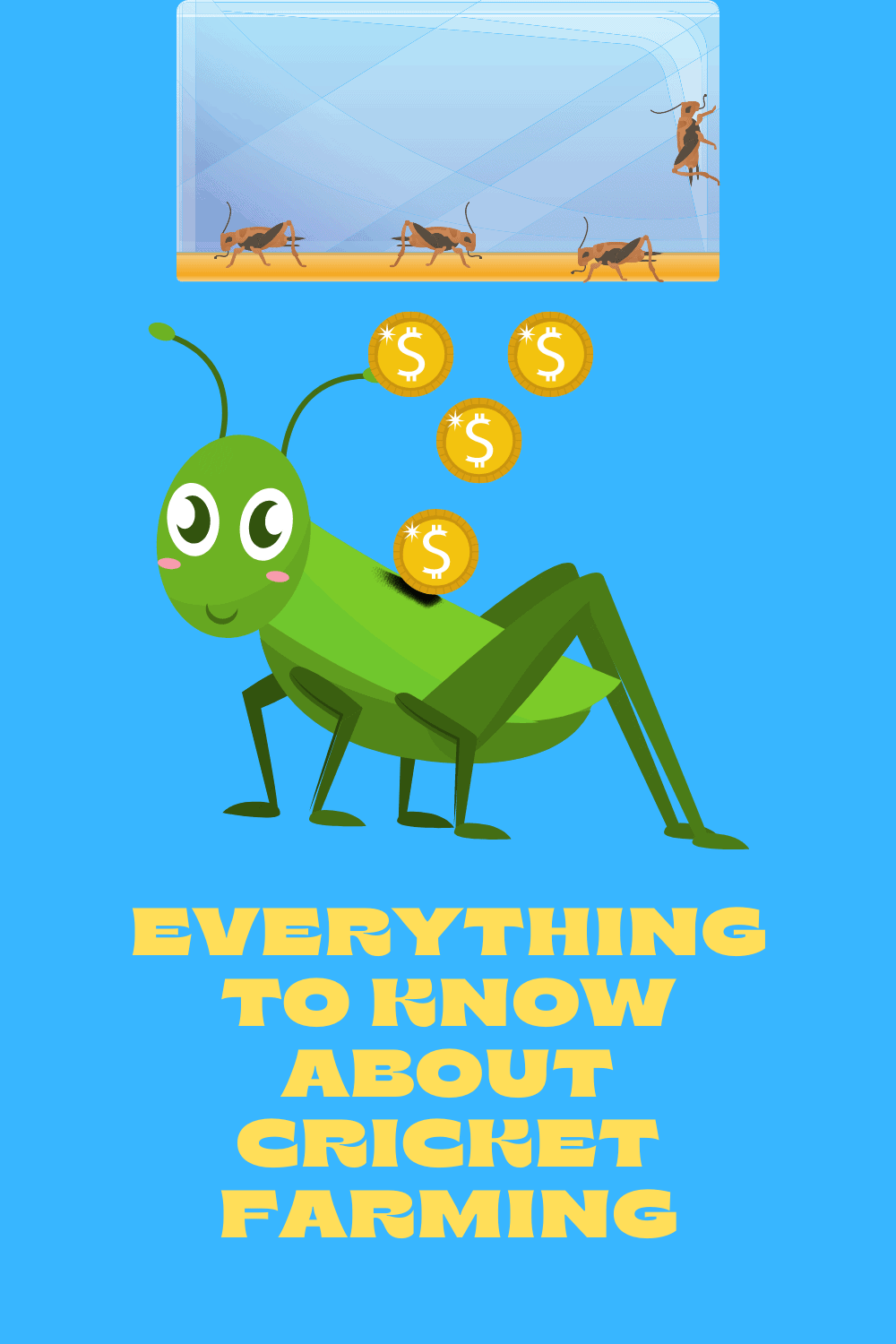
Jeffery Jago is a expert in horticulture and worm breeding. With a background in plant cultivation
Last Updated on May 4, 2021 by Jeffery Jago
Crickets are an excellent form of animal feed, and they also happen to be a popular food source in many parts of the world. Farming crickets can also bring in a solid income which makes being a cricket farmer very profitable work. In this article, we will discuss how you can start your own cricket farm so that you can reap all the benefits!
First of all, What is cricket farming exactly?
Cricket farming, or raising crickets on a farm for food and animal feed.
For the most part, it involves breeding these insects to be harvested at just the right time when they are full-grown and ready to lay eggs so that their population can grow over time.
There is a long history to cricket farming and it is often practiced in the most impoverished and remote areas of the world. But more and more it’s finding popularity in North America and the rest of the world.
So why would YOU personally want to start a cricket farm? Well, here are a few good reasons.
As an animal feed
If you’ve got chickens or reptiles or birds, Crickets make a great sustainable food source. They are high in protein and add a lot of variety to the animals’ diets.
Crickets can be ground up or crumbled with dry dog food, cereal, fruits and vegetables for a nutrient-rich mix that your pets will love! (If you’re interested in this option) and depending on what animals you intend to feed.
For human consumption, crickets can be turned into a variety of delicious snacks, and you can even bake with them by grinding them into protein flour. Many bodybuilders swear by it.
So not only is it good for your pets, but it also saves you a lot of money when buying ordinary animal feed (which is always a plus!).
So if you’ve got reptiles, chickens, or birds and you’re thinking about starting a cricket farm, this is something to think about.
For fishing bait
A farm might be slightly overkilling if all you are doing is fishing with them, However, it never hurts to have too much bait after all. So in that respect, Farming crickets are a great way to have an overabundance of fishing bait.
Commercial cricket farming
You can make a lot of money from cricket farming. The market is there for it and people are willing to pay because the demand is so high. I dare you to go to Amazon or Etsy and look for all the homegrown delicious snacks that cricket farmers make and sell online.
Then go ahead and take a look at the unit sold history and the price point for each product. You will start to get an idea of just how valuable crickets are. There is a lot of money to be made in this underdeveloped industry.
So if you are an entrepreneur, or even just someone who wants to make a little extra money on the side, you should start looking into cricket farming.
For your own human consumption.
Crickets are a great way to diversify your food. They’re not just for people who can’t eat gluten or dairy products, because they provide an excellent source of protein without the excess fat and calories than red meat provides. This makes them perfect for anyone on the Paleo diet, which is popular these days with all the health blogs promoting it.
Per 100 grams of cricket, it contains about 20 grams of protein, which is a great amount for those who want to get their recommended intake.
Crickets have not been genetically modified (assuming you personally haven’t genetically modified them)
This means that they’re healthy and good for you in ways that other meats are not. They also have the added bonus of being free from antibiotics and hormones, so there’s no risk of getting sick by eating them!
Ok, you’re convinced, right? So what now, How do you start a cricket farm?
Step 1: Get their enclosure ready
This means that you will need to set up a place for them. The enclosure should be somewhere warm, where there’s plenty of fresh air and sunshine all day long – not in your basement!
In general, you will need a 14-gallon bin, some egg cartons, or other similar cardboard enclosures. You want high sides so your crickets can’t escape or climb out. A tip for that is to add a bit of baby powder to the sides of the bin which will prevent them from being able to climb up.
A cricket’s water dish should be shallow so they can’t drown. An optimal setup is a small bowl or plate with a sponge that crickets can stand on top of and drink out of. The cricket sponge is also a good indicator of water contamination and should be changed out every 2 days.
Most importantly, Make sure the bin is well ventilated.
Step 2: Buying your first set of crickets
Once you have everything set up, it is time to buy some crickets. You can find them online or at local pet stores like Petco or Petsmart, but it’s much better to get in touch with another breeder you can trust. Crickets are usually sold by the pound with prices starting around $0.99 per pound (more expensive) online.
Prices will of course vary by your location. Some may be much more expensive (10 cents per cricket) for example.
Since your just getting started, you will need about 500 crickets to feed your farm.
So, you would need about $50 worth of crickets if they were sold at a rate of 12 cricket per pound.
It’s best to contact someone from an online forum or another breeder for specifics on prices in your area too! Always haggle.
Step 3: Feeding the crickets
Buy the Cricket Feed from your cricket breeder or pet store. Depending on what you’re using your crickets for, their feed can change wildly. Crickets taste like what they eat, so it’s important we choose the correct feed. This is especially true if they are going to be used for human consumption.
There are specialty breeder foods you can order online for feeding human consumption crickets. If you’re just using them for livestock and pets, Then any normal cricket feed should do just fine.
Don’t forget to feed them the occasional fresh vegetables, such as:
- Cucumber
- Pumpkin
- Zucchini
- Carrots
- Cauliflower
- Broccoli
- Arugula
Lettuce. Crickets can eat up to 50% of their diet in vegetables, so it’s important that they get a well-rounded diet for good health and growth. A balanced diet is crucial for animals’ overall fitness and production rates as it provides them with the nutrients they need to grow healthy and strong. If you’re going to be raising crickets from eggs, then feed them egg mix until they reach adulthood where you’ll switch over to adult cricket food.
Step 4: The hatchery trey
Crickets don’t give live birth, They simply ley eggs. For them to do this, they require a thin layer of topsoil in the “hatchery trey”. This can be as simple as the top of a coffee can lid. As long as they are able to get in and out, It should be fine. Here, newly-laid eggs will stay until they hatch. Remember to mist it with water once a day to keep it at a desirable moisture level for the eggs and for the crickets who want to ley their eggs there.
Once you start seeing enough eggs sticking out of the dirt (they appear to be little grains of rice), it’s time to move the entire tray into the egg incubation setup.
Step 5: Egg incubation
Cricket eggs need 90% humidity to hatch. That means a relatively warm temperature. This is most easily done in a separate container from the other crickets.
There are a couple of ways to achieve this, you could use an actual incubator which might be more expensive Or a simple heat lamp. You can also use a heating pad in a container with an inch or two of water in the bottom.
I recommend using some kind of heating pad if you’re just starting out because it’s cheap and easy to replace as needed but do make sure that your egg incubation setup is completely closed off from any other crickets so they don’t end up trying to lay eggs in there.
At this point, you will continue to spray the eggs at least once a day with water. It will take about 7-10 days for them to hatch into baby crickets.
Step 6: Be mama to the babies
One of the major problems with cricket farming is how we need to split up each stage of their life cycle into their own separate containers. Adults in the adult container, eggs in the egg container, and babies- you guessed it!
The baby crickets will need food about twice a day. If they are mostly eating legumes or other vegetables then that’s great but if not I recommend supplementing with some kind of pet food like a cat or dog chow mixed into their diet to ensure they’re getting all their essential nutrients from proper sources. You’ll also want to make sure your water is changed every few days so we don’t have any icky moldy stuff growing inside.
It’s important to give them something soft for them to burrow under too because this provides protection from “predators” (safe feeling cricket is a happy cricket) as well as regulating temperature and humidity levels. The humidity levels can be brought down to the same as adult crickets.
Wow, that was easy, wasn’t it? Once you get it down pat you will have a continuous supply of cricket proteins to do with whatever you wish. Including making some cold hard cash.
Speaking of, Just out of curiosity, What kind of cash can you make with a cricket farm?
The average is about $1500 per month but there are people making anywhere between $1000-$3000 per month and some even more than that. So really anything is possible here–even earning over six figures annually as many farmers do. There definitely seems to be a lot of potentials when we look at all the available mediums we can use to sell our crickets.
An example i gave earlier was etsy. I see cricket snack products all the time on etsy and they go for ridiculous prices. Sometimes a small snack bag of baked and seasoned whole crickets can go for as much as 40$ to some posh Etsy buyers.
So we can easily see the monthly average price ceiling can go quite high.
Pet stores are also often willing to buy crickets from local farmers because they get to say they sourced them locally. It’s often cheaper for them to do so as well. So be sure to try and contact all your local pet stores and feed stores and offer them your services.
In conclusion:
Cricket farming is a great way to get into the agricultural business and also provide yourself with an animal feed, for making money, and its health benefits. There are many other ways you can make money from your cricket farm as well depending on how much time you have available but these are the three main ones. Cricket farms can be started very easily by anyone who has access to some land or even just their backyard. The only things that need to happen first before starting one is getting the enclosure ready, buying crickets (for both food and breeding), feeding them properly so they grow quickly enough without dying of starvation or overcrowding in our enclosures, breeding them when they reach reproductive age which will differ between species but usually around two months.

